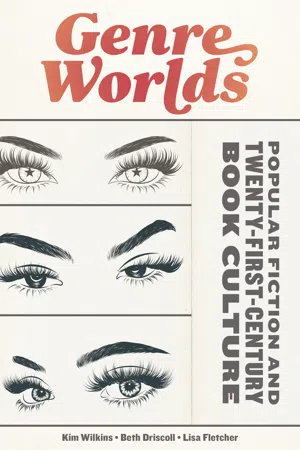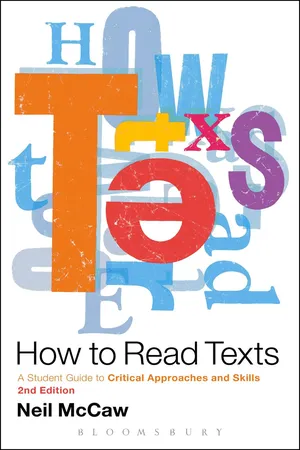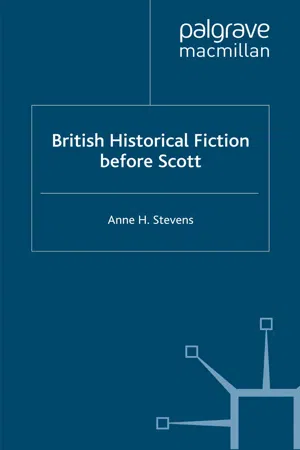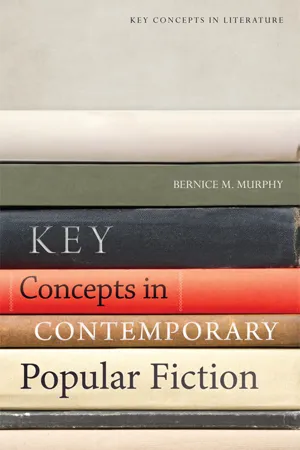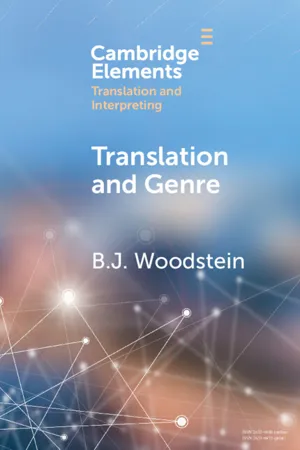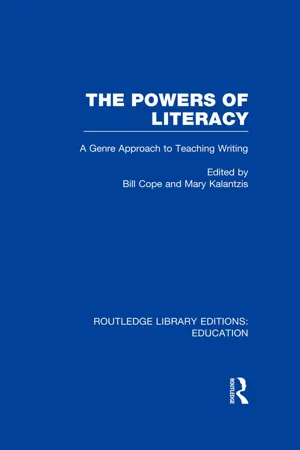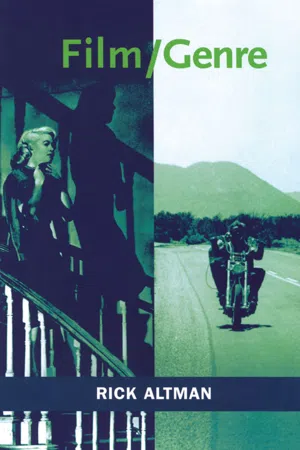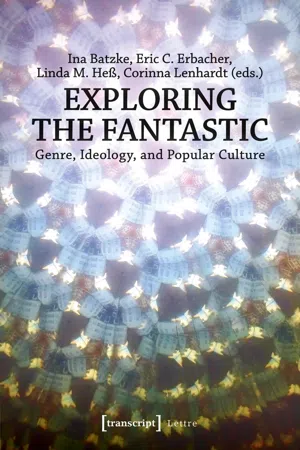Literature
Genre Fiction
Genre fiction refers to works of fiction that fit into specific categories or genres, such as mystery, romance, science fiction, fantasy, and horror. These genres have distinct conventions and tropes that help readers identify and enjoy the particular type of story they are looking for. While genre fiction is often seen as distinct from literary fiction, it can still offer complex characters, compelling themes, and thought-provoking narratives.
Written by Perlego with AI-assistance
Related key terms
1 of 5
11 Key excerpts on "Genre Fiction"
- eBook - PDF
Genre Worlds
Popular Fiction and Twenty-First-Century Book Culture
- Kim Wilkins, Beth Driscoll, Lisa Fletcher(Authors)
- 2022(Publication Date)
- University of Massachusetts Press(Publisher)
Though other, earlier, theo- rists may be more likely to use the term “popular fiction,” saving genre for discussing specific cases, we follow Gelder’s lead that the terms “popular fiction” and “Genre Fiction” are largely interchangeable: as Gelder writes, “popular fiction is Genre Fiction.” 21 We use both “Genre Fiction” and “popular fiction” throughout this book. Literary studies remains an important touchstone for our research, particularly work with a broad focus; however, we also draw on sociologically 12 CHAPTER 1 inflected, book history–informed scholarship on Genre Fiction. We are interested in investigating the ways people work together in publishing houses and other sites across genre worlds to produce the novels that fascinate us and so many others. We are therefore influenced by researchers who have addressed popular fiction’s creation and publication, as well as (often) its reception. For example, as noted above, Janice Radway’s Reading the Romance is partly an ethnographic study of a romance readers community in the pseudonymous town of “Smithton,” while Frank Felsenstein and James J. Connolly’s What Middletown Read situates a cache of data about library borrowing in Muncie, Indiana—including the borrowing of best- selling popular fiction titles—in a history of the town’s cultural and civic development around the turn of the twentieth century. Nicola Humble’s work on historical readers of popular fiction and Danielle Fuller’s research into writing and reading communities in Newfoundland, Canada, are other examples of the broader sociological approach that inspires us. We follow, too, in the tradition of research that discusses popular fiction as a cultural and commercial sector of print culture, including David Carter’s research on the historical middlebrow, Beth Driscoll’s work on the contemporary middlebrow, and the work on the production and distribution of pulp fiction by Paula Rabinowitz, Erin Smith, and Michael Denning. - eBook - PDF
How to Read Texts
A Student Guide to Critical Approaches and Skills
- Neil McCaw(Author)
- 2013(Publication Date)
- Bloomsbury Academic(Publisher)
As we are looking in this chapter at how a reader might draw specifically on genre and literary/cultural history as contexts, the first stage is to consider how to define our subject matter: Genre a kind; sort; style b A particular style or category of works of art; esp. a type of literary work characterized by a particular form, style, or purpose. Oxford English Dictionary ( OED ) In these senses genre is either a broad categorization or else the grouping of artworks based on shared characteristics. Either way the implication is that there are common codes and conventions shared by different texts, an idea that has been prevalent in critical writing from as far back as Plato’s division of written texts into poetry, drama and prose. Aristotle subsequently defined tragedy, epic, comedy and parody. In fact, writers from all eras have been interested in looking at categories of artistic form(s): Reading genre and literary/cultural history 87 It is impossible that anyone who inhabits the same age with such writers as those who stand in the foremost ranks of our own, can conscientious-ly assure himself that his language and tone of thought may not have been modified by the study of the productions of those extraordinary intellects. It is true, that, not the spirit of their genius, but the forms in which it has manifested itself [my italics], are due less to the peculiarities of their own minds than to the peculiarity of the moral and intellectual condition of the minds among which they have been produced. 1 For Shelley, by considering the formal/genre context a reader gains a clearer under-standing of the way in which writers work and the process through which their writing takes shape. Just as in the twentieth century critics identified the notion of genre as one of the key ‘structures’ of literary history. - eBook - PDF
Detective Fiction and The African Scene
From The Whodunit? To The Whydunit?
- Linus Asong(Author)
- 2012(Publication Date)
- Langaa RPCIG(Publisher)
Although it is hard to find an airtight and really comprehensive definition of most literary concepts, the concept of the genre as commonly presented to the public is quite often too narrow or too wide, even when this is done by people whose attitude towards the works is positive. H. Douglas Thomson (1962:129), described by Howard Haycraft as the “first major historian anywhere on contemporary police romance as living 11 literature,” defines it as “a problem; a dramatic problem, a ‘feather to tickle the intellectual.” S.S. Van Dine (1974:17) (Williard Huntington Wright) says: The detective novel does not fall under the head of fiction in the ordinary sense, but belongs rather in the category of riddles: it is, in fact, a complicated and extended puzzle cast in fictional form. Its widespread popularity and interest are due, at bottom and in essence, to the same factors that give popularity and interest to the cross-word puzzle. These statements and many more which stress only the puzzle element in the works, may be ideal for a book-seller or a librarian in classifying works on the shelf. But as definitions, they fail in that they only serve to emphasize the distance between the genre of detective fiction and the so-called “serious literature.” As a viable division of literature, the least that can be said about the best example of it is that it is a full-length work of fiction in which the writer arouses and sustains interest by employing every possible requirement of good writing in the investigation and solution of the mystery surrounding a crime. This way, the gap between good detective fiction and good literary fiction can be seen to be a very narrow one. Purpose of Literature of the Genre The purpose which detective fiction is generally believed to have been created to serve - that of temporary “escape” from frustrations of life, or vicarious experience - is another major cause of the disgrace the genre continues to suffer. - eBook - PDF
- S. Keen(Author)
- 2003(Publication Date)
- Palgrave Macmillan(Publisher)
differences define them, genre as it operates within and among texts often invokes metaphors of boundary, border regions, and the notion of crossing over from one literary realm to another. This aspect of genre is explored below. Genre in narrative fiction can be conceived as a list of what are variously known as types, kinds, or subgenres. From among these synonyms the advanced student can select a term to indicate subdivisions of narrative; none of them is without drawbacks. Kind, a venerable term with roots in Renaissance genre taxonomies, can sound casual or breezy to a contempor- ary reader. Type carries an implication of typicality that a student may not intend. The term subgenre, my own choice, unfortunately suggests lowness in a hierarchy, but it has the advantage of containing the word ‘genre’ within it, which helps avoid confusion. Narrative subgenres include: adventure; allegory; ballad; Bildungsroman; comic novel; detective fiction; dime novel; domestic fiction; epic; fable; fairy tale; fantasy; fictional auto- biography; gothic; historical fiction; horror story; industrial novel; metafiction; multi-plot novel; mystery; naturalist novel; novel of ideas; parable; postmodern novel; pulp fiction; realistic fiction; romance; satire; short story; science fiction; social problem novel; thriller. Telling these subgenres apart depends on recognizing the sort of plot lines, character types, settings, time periods, tones, broad themes, and a number of other particular conventions shared by works bearing their labels. Gérard Genette cautiously observes, ‘The properly (sub)generic cate- gories are apparently always connected to thematic specifications. But that question requires closer examination’ (Architext, 75 n. 79). Theme alone does not account for generic grouping or generic difference, for some markedly different subgenres share themes, but it can be an important portion of a generic category. - eBook - PDF
- A. Stevens(Author)
- 2010(Publication Date)
- Palgrave Macmillan(Publisher)
In the contemporary context, likewise, historical novels can be found both on the bestseller lists (in the cases of the novels of James Michener and Patrick O’Brian, for instance) and critics’ lists. Critically acclaimed contemporary authors from Toni Morrison to Thomas Pynchon have tried their hand at historical fiction. Many other novelistic subgenres, such as crime fiction or science fiction, have stronger associations with popular or ‘genre’ fiction and are often relegated to separate genre-based sections at the local bookstore. Frequently when a ‘literary’ author uses the conventions of one of these other popular genres, such as Margaret Atwood’s use of science fiction in The Handmaid’s Tale or Paul Auster’s use of crime writing in The New York Trilogy , critics consider these works as postmodern acts of generic appropriation rather than genuine examples of the genre. Historical fiction, by contrast, has avoided this sort of ghettoization; identifying a work as a historical novel tells you something about its setting but little about its artistic aspirations – it is a fictional genre that does not suffer the stigmatizing label of ‘Genre Fiction.’ Just as in the twentieth century historical fiction has remained part of the fictional mainstream, in the eighteenth century the history of the historical novel parallels and illuminates the story of the rise of the novel more generally. - eBook - PDF
- Bernice M. Murphy(Author)
- 2017(Publication Date)
- Edinburgh University Press(Publisher)
MAJOR POPULAR GENRES 123 Horsley, Lee (2010), ‘From Sherlock Holmes to the Present’, in Lee Horsley and C. J. Rzepka (eds), A Companion to Crime Fiction , Oxford: Wiley Blackwell, pp. 28–42. James, P. D. (2011), Talking about Detective Fiction , New York: Vintage. Knight, Stephen (2010), Crime Fiction since 1800: Detection, Death, Diversity , Basingstoke: Palgrave Macmillan. Priestman, Martin (ed.) (2003), The Cambridge Companion to Crime Fiction , Cambridge: Cambridge University Press. Schecter, Harold (ed.) (2008), True Crime: An American Anthology , New York: Library of America. Romance In its original usage the term ‘romance’ was (and still is) deployed in relation to medieval and Renaissance works of fiction featuring an emphasis on martial deeds as well as scenes of courtship and love. It has also been used to describe the work of authors writing in a non-realist or allegorical vein. Within a popular fiction context, however, the term always refers to stories in which the main focus of narra-tive interest development is a romantic relationship. As Pamela Regis argues, ‘A romance novel is a work of prose fiction that tells the story of the courtship and betrothal of one or more heroines’ (2003: 22). However, as Regis and others have noted, marriage is by no means always the outcome in contemporary romance novels, which increas-ingly reflect the financial and social independence of their overwhelm-ingly female readers. Statistics on the Romance Writers of America (RWA) website indicate, at the time of writing, that 84 per cent of American romance novel writers are female. A romance may be set in any time period (‘historicals’ have always been very popular). It may have a heroine and hero of any socio- economic, religious, national or educational background. Increasingly, the genre has become more diverse, and it is now not uncommon to find non-white characters as well as gay, lesbian and bisexual protago-nists and love interests. - eBook - PDF
- B. J. Woodstein(Author)
- 2022(Publication Date)
- Cambridge University Press(Publisher)
If the concept of ‘child’ is so confusing, then so must be the field of children’ s literature. How can we define a supposed genre if we cannot define its reader- ship? While we generally differentiate between children’ s literature and young adult literature, it may make sense to break the category down even further, such as by referring to subtypes, including board books, alphabet books, picture books, early readers, middle-grade novels, young adult novels and so on. Or perhaps that is the wrong way to divide what is a very large grouping of texts linked by little more than their young audience. We could, on the contrary, divide works for children according to, well, their genre. There are works for children that can be called science fiction, non-fiction, romance, horror, mys- tery, family sagas, fairy tales, poetry and much more. This means that what is often considered a genre in and of itself – children’ s literature – is actually a broad field that contains many genres. As with the other genres, or categories, explored heretofore, calling a field of disparate works a genre may be done out of ease. Adults in the bookstore or library want to know if a given work is appropriate for the young person they are getting it for. The use of the category or genre name shows consideration for the needs of both the children themselves and the adults who make many of the decisions about what texts children have access to. It is a marketing decision, one that is further emphasised by the use of age bands, those labels on books that 44 Translation and Interpreting specify what age range a book is considered to be for. We do not find such age bands on adult literature – that is, ‘This book is appropriate for those in their thirties’ – but we do tend to employ them in children’ s literature, despite knowing how different two children of the same age could be in their develop- ment and reading abilities and interests. - eBook - PDF
The Powers of Literacy (RLE Edu I)
A Genre Approach to Teaching Writing
- Bill Cope, Mary Kalantzis(Authors)
- 2014(Publication Date)
- Routledge(Publisher)
As human Ambassador Genly Ai struggles to deal with his Gethenianhosts, the prejudices and opinions, behavioursand attitudes of a patriarchalman and the society from which he comesare exposed and examined. LeGuin'sscience fIction novel is a site for the critical deconstruction of contemporary societyandfor the reconstruction of gender discourses and gender identities. This chapter discusses the ways in which the readingand writing of feminist genre flCtion, such as science fiction, offer a model of a critical methodology which can be used by teachers in the development of an empowering pedagogy, a critical literacy. 91 The Powers of Literacy Genre as a Critical Category The flrst points to consider in relation to this aim are the choice of' genre' flction as a model and the meaning of the term 'genre'in this context. After all, all texts are generic; they are all constructed and read in relation to usually one dominant accepted literary (or non-literary) category. They may divergefrom the conserva- tive functioning of that genre,perhaps througha mixing of different genres in the one text, but they nevertheless can be identified and made meaning of by their relationship(s) with one or more genres. Here we might be talking of the realism of Henry Jamesor the fantasy of Marion Zimmer Bradley, the modernism of James Joyce or Sara Paretsky's detectiveadventures of V.I. Warshawski,or the postmodern pyrotechnics of Calvino or Pynchon. It is important to address this notion of 'genre' because the critical, de constructive practice developed by feminist readers and writers began in their analysis of this term as a pejorative and dismissive label for many kinds of writing. The word 'genre' came to be a pejorative label for literature in the late eighteenthand early nineteenthcentury. Before this, during the period of the Enlightenment and earlier, 'generic'was a positive term; good fiction was flction that followed and improved on its dominant generic predecessor(s). - eBook - PDF
What Are the Gospels?
A Comparison with Graeco-Roman Biography
- Richard A. Burridge(Author)
- 2018(Publication Date)
- Baylor University Press(Publisher)
98-245. 88. Fowler, Kinds of Literature, p. 212. 89. Doty, ‘The Concept of Genre’, p. 439. 90. Dubrow, Genre, pp. 116-8. series of earlier forms.’ 91 So genre must always be set in its historical context. Study of the historical context will include analysis of which genres were ac-tually available at the time. Although there is a great variety of genres possi-ble, the dictates of literary fashion and canon mean that ‘each age has a fairly small repertoire of genres that its readers and critics can respond to with en-thusiasm. And the repertoire easily available to its writers is smaller still.’ 92 Therefore, it is no use censuring Mark for not writing in the conventions and genre of, for example, modern investigative journalism; this was just not available to him. He could develop a new genre by extending those available perhaps, but a leap of that magnitude into the unknown is not possible. Fitting genres into their literary network is sometimes represented by drawing genre maps. While this can occasionally have some illustrative use, as in the next chapter, such maps do have their limitations: ‘Genres are better understood . . . through a study of their mutual relations . . . . These relations are partly diachronic or dynamic (formation, combination, mixture), partly static (similarities, contrasts).’ 93 Hierarchies of genres were important for classical prescriptivism, as in the hierarchies proposed by Aristotle, Cicero, Horace or Quintilian. However, generic hierarchies are just as susceptible to change and literary fashion as everything else generic. 94 5. Summary Genres are dynamic and flexible groupings whose boundaries and labels shift. Generic development moves from initial origins through three main stages. No genres develop ex nihilo: instead, they extend or amalgamate other exist-ing genres. Developed genres are open to further mixture and modulation. - eBook - ePub
- Rick Altman(Author)
- 2019(Publication Date)
- British Film Institute(Publisher)
In short, film genre study has over the last two decades established itself as a field separate from literary genre study. As such, it has developed its own assumptions, its own modus operandi, and its own objects of study. This chapter will be devoted to a sketch of recent approaches to film genre. This overview is based primarily on book-length studies of major genres, along with particularly influential articles. The positions described are not necessarily the ones touted on book jackets or in theoretical introductions, however, but derive from the actual praxis of current genre study, i.e., the theory that emerges from the practice of genre criticism and history. I do not agree with all the methods or conclusions presented in this chapter. Indeed, the rest of this book will offer alternatives to many of the positions presented. Nevertheless, it is important for readers to understand the classical tradition of film genre studies as a basic context for the proposals that will be made in subsequent chapters. For this reason, the following ten claims have been presented in as straightforward a manner as possible, with little attempt to present variant positions or to criticize potentially problematic stands and strategies. Genre is a useful category, because it bridges multiple concerns Comic books are full of contraptions capable of performing multiple tasks. Genre is usually seen as just such a device. Only slightly short of magical in its versatility, genre endures within film theory because of its ability to perform multiple operations simultaneously. According to most critics, genres provide the formulas that drive production; genres constitute the structures that define individual texts; programming decisions are based primarily on generic criteria; the interpretation of generic films depends directly on the audience’s generic expectations - eBook - PDF
Exploring the Fantastic
Genre, Ideology, and Popular Culture
- Ina Batzke, Eric C. Erbacher, Linda M. Heß, Corinna Lenhardt, Ina Batzke, Eric C. Erbacher, Linda M. Heß, Corinna Lenhardt(Authors)
- 2018(Publication Date)
- transcript Verlag(Publisher)
Genre Belief, Potentiality, and the Supernatural: Mapping the Fantastic D ANIEL S COTT Genre definitions are necessarily problematic in that they attempt to impose rules and boundaries where no tangible ones exist. At the same time, we presuppose genre by default, and disproving genre is certainly as difficult, if not more so, than proving it. In talking specifically about fantasy literature, we are of course intentionally begging the genre question in itself, but it becomes inescapable once we start considering specific genre subcategories and their functions. And despite the many pitfalls that genre discussion contains, it can be rewarding to analyze the connections between the fantasy genre and certain modes of thought. Since my research deals with the intermeshing of theist and atheist thought with fantastic genres, I needed a working genre definition with which to frame the fantastic. It was here that traditional definitions of the fantastic proved to be use-ful but often ultimately inconclusive, since they could not account for varying viewpoints of the reality from which fantasy derives. This is critical because Christian speculative fiction, an example of theist fiction, shows that our concep-tions of fantasy as non-reality do not account for varying epistemic stances of re-ality, in this case, for the divergence between how atheists and theists perceive the world. I therefore set forth a broad but hopefully comprehensive definition of fanta-sy that encompasses “classic” fantasy fiction as well as works of science fiction and Christian speculative fiction. This definition, though it accepts diverging ep-istemic viewpoints and attempts to avoid bias, is based on an evaluative system that both theists and atheists must necessarily subscribe to: grammar.
Index pages curate the most relevant extracts from our library of academic textbooks. They’ve been created using an in-house natural language model (NLM), each adding context and meaning to key research topics.
